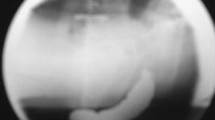Abstract
PURPOSE: This study was undertaken to determine the outcome and changes produced by an endorectal anterior wall repair in objective functional parameters using anorectal manometry and defecography and to asses their usefulness in the selection of patients for the operation. METHODS: Between 1986 and 1990, we performed a prospective study of 76 consecutive patients with symptomatic rectocele and/or an anterior rectal wall prolapse. All patients were studied prospectively according to a fixed protocol. Standard questionnaire, defecation diary, clinical examination, defecography, and anal manometry were performed preoperatively and three to four months postoperatively. RESULTS: Three months postoperatively, 38 patients (50 percent) had no complaints at all (excellent result), 32 (42 percent) had only a minor complaint (good result), and in 6 patients (8 percent) the complaints were essentially unchanged (unsatisfactory result). After one year, similar figures were obtained. The postoperative mean stool frequency in all patients after three months was significantly increased (P<0.05) but not after one year. Postoperative defecographies showed a complete absence or significant diminution of the rectocele at three months and were significantly correlated with relief of symptoms. An inverse correlation was found between improvement in incontinence grade after operation and (larger) preoperative volume at which urge to defecate was elicited, making it a good predictor of improvement in incontinence by the operation. CONCLUSIONS: The anterior rectal wall repair positively influences rectal sensation in patients with incontinence and/or obstructed defecation caused by a rectocele and/or an anterior rectal wall prolapse. Anorectal manometry was useful in studying the beneficial physiologic effects of the endorectal repair. In patients with no previous pelvic surgery, a large urge to defecate volume is a good predictor of a good clinical outcome.
Similar content being viewed by others
References
Bouchacha M, Denis P, Arhan P,et al., Morphology and rheology of the rectum in patients with chronic idiomatic constipation. Dis Colon Rectum 1989;32:788–92.
Sullivan ES, Leaverton GH, Hardwick CE. Transrectal perineal repair: an adjunct to improved function after anorectal surgery. Dis Colon Rectum 1968;11:106–14.
Capps WF. Rectoplasty and perineoplasty for the symptomatic rectocele: a report of fifty cases. Dis Colon Rectum 1975;18:237–43.
Uhlig BE, Sullivan ES. The modified delorme operation: its place in surgical treatment for massive rectal prolapse. Dis Colon Rectum 1979;22:513–21.
Khubchandani IT, Sheets JA, Stasik JJ, Hakki AR. Endorectal repair of rectocele. Dis Colon Rectum 1983;26:792–96.
Delorme R. Sur le traitement des prolapsus du rectum totaux par l'excision de la muqeuse rectale au rectalcolique. Bull Mem Soc Chir Paris 1900;26:498–518.
Barron J. Office ligation for internal hemorrhoids. Am J Surg 1963;105:563–70.
Mahieu P, Pringot J, Bodart P. Defecography: 1. Description of a new procedure and results in normal patients. Gastrointest Radiol 1984;9:247–51.
Shorvon PJ, McHugh S, Somers S, Stevenson GW. Defecography findings in normal volunteers: results and implications. Gut 1989;30:1737–49.
Holschneider AM. Inkontinenz. Elektromanometrie des Enddarms. 2nd ed. München: Urban & Schwarzenberg 1983;4:213–33.
Wald A, Tungunguntla AK. Anorectal sensation dysfunction in fecal incontinence and diabetes mellitus. N Engl J Med 1984;310:1282–87.
Roe AM, Bartolo DC, Mortensen NJ. A new method for assessment of anal sensation in various anorectal disorders. Br J Surg 1986;73:310–12.
Sedgewhich EM. Clinical application of the spinal and cortical somatosensory evoked potentials. Amsterdam: Exerpta Medica 1981:207–14.
Latimer PR, Campbell D, Kasperski J. A components analysis of biofeedback in the treatment of rectal incontinence. Biofeedback Self Regul 1984;9:311–24.
Duthie HL, Watts JM. Contribution of the external anal sphincter to the pressure zone in the anal canal. Gut 1965;6:64–8.
MacLeod JH. Management of anal incontinence by biofeedback. Gastroenterology 1987;93:291–4.
Sun WM, Read NW, Miner PB. Relation between rectal sensation and anal function in normal subjects and patients with fecal incontinence. Gut 1190;31:1056–61.
Bielefeldt K, Enck P, Erckenbrecht JF. Sensory and motor function in the maintenance of anal continence. Dis Colon Rectum 1990;33:674–8.
Whitehead NE, Orr WC, Engel BT, Schuster MM. External anal sphincter response to rectal distension: learned response or reflex. Psychophysiology 1982;19:57–72.
Author information
Authors and Affiliations
About this article
Cite this article
Janssen, L.W.M., van Dijke, C.F. Selection criteria for anterior rectal wall repair in symptomatic rectocele and anterior rectal wall prolapse. Dis Colon Rectum 37, 1100–1107 (1994). https://doi.org/10.1007/BF02049811
Issue Date:
DOI: https://doi.org/10.1007/BF02049811




